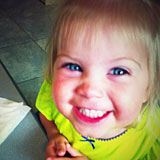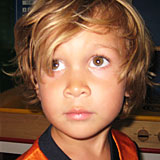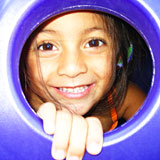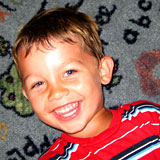Matching Your Child's Personality to the Right Child Care Setting
Selecting a childcare provider is one of the most important decisions that you will make as a parent. It can also be a stressful one! You may find yourself feeling:
- Positive - "I'm looking forward to going back to work."
- Anxious - "Will they really give my child enough attention?"
- Ambivalent - "I want to go back to work, but I feel guilty about leaving my child with someone else."
- Jealous - "Will my child still know that I'm their mother/father?"
- Sad - "I am going to miss my child so much!"
- Vulnerable - "I'm on the waiting list...will there be space for my child? What will we do if there's not?"
- A Loss of Control - "What if something happens and I'm not there?"
Feelings like these are normal. Talking with other parents and your chosen childcare provider can help with the transition. As a parent, you know your child best. Below are some guidelines on how to use what you know about your child; their personal style, activity level, need for social interaction, and tolerance, to select a child care setting that's right for your child. Use the questions below to develop a profile of your child and to learn more about the type of care that might meet his or her needs best. Additionally, many parents find themselves making child care arrangements before their baby is born. That's normal and, often, necessary. Once you have had a chance to get to know your baby, use these guidelines to help you re-evaluate your child's child care arrangement. Does it compliment your child's needs? Encourage his or her strengths?
Among the items discussed below, there is one common theme: the need for a childcare provider to adapt their approach to meet each child's needs. This is called responsive care. To do so, providers need to be excellent observers of the children in their care and search for the meaning behind children's gestures, gurgles, cries, and glances. Responsive childcare providers wonder why a particular behavior is occurring, come up with an educated guess, and interact with the child to see if they're correct. Is a crying baby tired? Hungry? Wet? Lonely? Frustrated? Responsive childcare providers adapt their responses based on the reason behind the behavior, as well as the style and personality of each child. This ensures that all children are treated as unique individuals, with their own thoughts, feelings, needs, and preferences.
What is your child's personal style? |
|
If most of the time, your child is: |
Look For: |
AdaptableYour child is flexible, and approaches new situations and new people with ease. Your child doesn't usually have trouble with transitions and tends to "go with the flow". |
Large group settings that provides lots of opportunities for social interaction and new experiences. |
CautiousYour child is thoughtful, and approaches new situations and new people slowly (and sometimes with fear). He or she often has difficulty with transitions and needs lots of support to feel safe and comfortable. |
Small group settings, which may be less overwhelming for your child. |
FeistyYour child is very passionate and feels things intensely. Your child often has difficulty controlling his or her strong feelings, wants, and needs. Your child may or may not work well with transitions, but either way, he or she always lets you know what he or she is feeling. |
Settings where each child is assigned a primary childcare provider, someone who knows them and understands their intense expressions of emotion. (Note: All children would benefit from this.) |
How does your child react to the world around them? |
|
If most of the time, your child has: |
Look For: |
Big ReactionsYour child tells the world whether he or she is feeling happy or sad, and doesn't hold back! Big reactors usually respond with equal intensity to physical stimuli (an itchy shirt tag) as well as to emotional stimuli (being denied a second cookie). |
Childcare providers who respect your child's feelings while helping him or her to express them in a more controlled way. You may also want to locate a program that uses behavior management techniques like, redirection (distracting the child with another toy, area, or activity), labeling feelings, and limiting choices. |
Low ReactionsAs infants, low reactors are often less demanding than other babies. They fuss very little, tend to be quiet, and sleep a lot. You may find yourself working harder to get their attention during play or other activities. |
Childcare providers who gently introduce new activities, and allow low reactors to choose their own toys and engage in the quieter activities they prefer. |
How active is your child? |
|
If most of the time, your child has a: |
Look For: |
High Activity LevelThese children are always on the go-crawling, climbing, toddling, and running until they drop. They will reach for, touch, and taste anything and everything. |
Settings that provide safe, active exploration and lots of opportunities for physical play. Also look for providers who allow for individual schedules, so that your child won't be expected to lie down or sit still for very long. |
Low Activity LevelThese children are content to sit quietly and explore the world through their eyes and ears. Their interest in the world around them is as sharp as high activity children, but their need to move about is fairly low. |
Providers who engage children in sensory-rich activities. |
How social is your child? |
|
If most of the time, your child is: |
Look For: |
Super-SocialDoes your child approach new people-adults and children with a smile and outreached arms? Super-social kids are most content when they are surrounded by, and interacting with, other adults and children |
Settings that encourage group play; a larger group program may be a good fit. |
Take-It-SlowChildren who prefer to "take it slow" may be more hesitant and shy around strangers, and need time to warm up before they feel comfortable or safe enough to join in. They may be happy to play alone, or with just one or two other adults or children. |
Providers who allow children to choose when they would like to meet and play with others; a smaller group program might be a good choice. |
Is your child tolerant of changes and challenges? |
|
If most of the time, your child has a: |
Look For: |
High ToleranceThese children don't seem to be too bothered by changes, whether it's a new babysitter, new shoes, or new food. Adaptable, they tend to cope with frustration well. They're persistent and patient, and keep trying even when faced with a difficult task. |
Settings that provide a mixed-age group of children, that offers challenging and stimulating activities and learning opportunities for your child. |
Low ToleranceLow tolerance children are sensitive to change and often become very upset when their routine is altered in some way. They are also apt to feel frustrated and lose patience when faced with obstacles (like a puzzle piece that won't fit). |
Settings that provide a same-age group of children where the toys, games, and activities are more uniformly targeted to your child's current level of development. |





